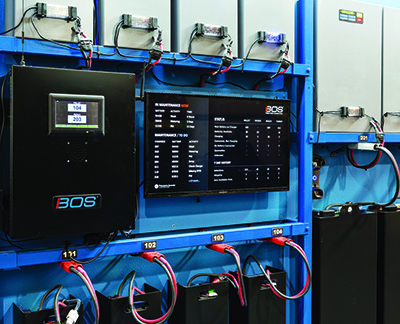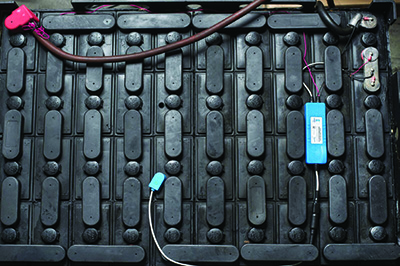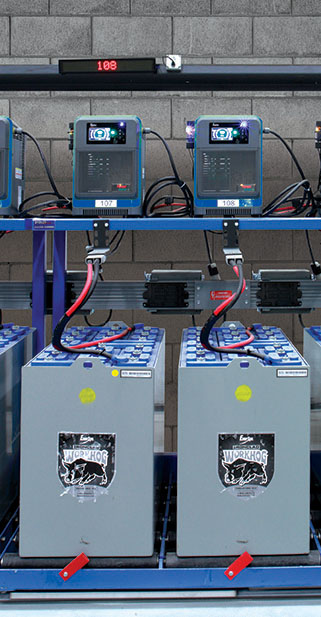New Dawn of Battery Managment
As fleet managers strive to optimize the usage and lifetime of batteries and chargers, they are embracing new approaches to battery and power management.

For many, the practice of managing lift truck batteries and chargers hasn’t changed in decades. Typically, batteries still receive weekly maintenance, watering and equalizing, and scheduled periodic maintenance events, perhaps on a quarterly or semi-annual basis.
The process sounds simple, but anyone who has been responsible for the management and maintenance of batteries and chargers—whether they’re overseeing operations in one facility or many—knows the obstacles to optimal battery management are wide ranging.
Battery and charger suppliers offer a variety of solutions to improve data collection and analysis, increase productivity, resolve problems and, ultimately, enhance the lifecycles of the equipment in a timely and cost-effective way. Nonetheless, the solutions are only as good as a fleet manager’s willingness to engage in battery management—a process that involves buy-in from operators, maintenance technicians and supervisors.
Using the Cloud
Often a complex, time-consuming process, battery management, if not conducted properly, can considerably shorten battery life and run times. After all, without adequate management, facilities may not only have more batteries than they need, but the batteries themselves may not be used correctly, eventually leading to a waste of time and money.
“However, battery management systems can eliminate the guesswork involved with managing battery fleets, while also saving money,” says Joe Posusney, director of marketing communications and field operations for Philadelphia Scientific. “By enabling a lean approach to battery management, the systems can help multi-shift distribution centers and warehouses effectively operate with a ratio of two batteries per forklift or less.”
This approach can be helpful for fleet managers encountering battery or charger issues like malfunctions and breakdowns. In the past, they had to call in service providers to inspect equipment—a process that could take a few days to complete, especially if spare parts were required.
Now, Cloud-based applications, like one offered by Advanced Charging Technologies (ACT), can remove much of the time and worry fleet managers spend on equipment issues. In fact, the tools can avoid malfunctions and breakdowns entirely, as some battery management solutions include trained engineers who identify potential issues, resolve them remotely or dispatch service with the spare parts needed to repair any malfunction. As a result, managers can greatly reduce, or even eliminate, their equipment downtime and focus on their operations.
Cloud applications also offers managers real-time analytics and reports of all batteries and chargers remotely, so they can supervise each of their facilities from any type of device, regardless of their location.
“The advanced analytics and reports generated by the application allow fleet managers to improve their daily and weekly equipment performance through proper usage and maintenance—by ensuring their batteries are adequately charged, equalized on scheduled days, and watered,” says Nasser Kutkut, chief technology officer at ACT. “Managers can also enhance their fleet utilization through right-sizing of batteries and chargers, and plan their equipment replacements based on historical usage.”
Enhanced visibility
More often than not, before fleet managers were able to measure and monitor battery and charger performance, operation and utilization actions were reactive. Managers simply would not know about a problem until a failure occurred. By that time, it was expensive to address secondary problems without detecting the primary root cause. The process was more guesswork than science.

With enhanced visibility, however, problems can be detected and resolved before they result in downtime. And, fleet managers can accurately predict replacement cycles, improve operations and reduce the risk of premature failure. To enhance fleet visibility and enjoy other benefits—like easily identifying improperly calibrated fuel gauges, maintaining warranty eligibility and acquiring utilization data for more accurate replacement budgeting—managers might use the following remote monitoring systems.
Battery-mounted module: According to Bill Rubenzer, vice president of Storage Battery Systems, an ideal remote monitoring system is comprised of a battery-mounted module—which monitors current, battery temperature and equalizing—and a wireless PC interface to collect data.
“The data can then be accessed by facility, corporate or outside service personnel over Wi-Fi, network or cellular means,” Rubenzer says. “Reporting software is then broken down into a battery/charger view, which is useful for day-to-day operation and troubleshooting as well as a facility view for the bigger picture. Graphics are used in the reports to allow for easier interpretation.”
Opportunity charging: When opportunity charging is properly applied, high-cycle, multi-shift operations don’t have to purchase spare batteries and changing equipment. The special opportunity chargers charge at higher charge rates (25-40 amps per 100ah vs. 16-18 amps per 100ah in conventional systems), and the batteries will usually have battery modules installed. As a result, the modules can communicate temperature, voltage and other data to the charger, thereby properly charging and protecting the battery.
“Opportunity charging can be used in facilities of all sizes,” Rubenzer says. “The key is to ensure that, if opportunity charging is selected, all factors have been considered, such as peak seasonal usage, future needs and the confidence of the operators on the floor, following the recommended charging regiments.”
Battery management tools: To further enhance visibility and maximize fleet performance, fleet managers can consider using battery management tools like those from AeroVironment, which can provide actionable intelligence about the health and state of electric forklift fleets—from warranty information to battery charge history.
“The tools also provide historical and predictive reports, which can be used to optimize the distribution of vehicles throughout a facility, train operators and plan for future orders or expansions,” says Ken Karklin, vice president and general manager of efficient energy systems for AeroVironment. “Managers may also receive real-time views of their fleet so they can immediately identify compliance problems and provide on-the-spot guidance for their operators.”
Enterprise-wide view
In the past, fleet managers typically only dealt with the equipment in their facility, but the concept of “every facility for itself” is fading as more managers pursue the efficiencies of sharing best practices between facilities by managing all of their fleets under one program. And, when managers oversee multiple sites, the benefits of battery management systems are even greater since they can right-size each of their sites, according to Posusney.
 “When fleet managers find excess batteries or trucks at one site, they can move those assets to the sites that need them—without purchasing additional batteries or trucks,” Posusney says. “Battery management systems can enable an enterprise-wide view that allows managers to maximize their fleet assets and know which assets are needed at each site.”
“When fleet managers find excess batteries or trucks at one site, they can move those assets to the sites that need them—without purchasing additional batteries or trucks,” Posusney says. “Battery management systems can enable an enterprise-wide view that allows managers to maximize their fleet assets and know which assets are needed at each site.”
Through this view, managers can also ensure each fleet is performing its best, while minimizing costs. This is critical, since some maintenance teams or service partners perform better than others, according to Chuck Wurl, territory sales manager for Eastern North Carolina at ABT Power Management. A common set of tools and benchmarks can ensure each service provider is accountable throughout the network.
“By leveraging one data system for all equipment, maintenance and performance data, the power and flexibility is put back in the hands of the sites, along with the corporate entity, to drive improvement,” Wurl explains.
With one data system, fleet managers can drive the same processes and procedures for service and maintenance across all facilities; ensure all equipment and maintenance data is in one place; evaluate performance and identify what is positively or negatively influencing performance; and use the same key performance indicators at each facility.
“In a perfect world, companies would build manufacturing or distribution sites that work exactly the same,” Wurl says. “Unfortunately, that doesn’t happen as companies expand and facilities age. But, through the analysis of power draw and charging routines, we have the ability to analyze power usage across a national fleet, and find where facilities can adopt best practices for power efficiency and achieve optimal uptime.”
Analyze, act, benchmark and forecast
For the past few decades, fleet managers focused primarily on the battery asset itself, as maintenance managers were traditionally responsible for keeping the assets running by measuring cell voltages and specific gravity, and checking cables, connectors, contacts and corrosion.

Since very little intelligence came from the battery, management was largely reactive—with virtually no insight into the daily “life” of the battery itself, according to Lynda Stephens, director of information solutions at EnerSys. However, by using a battery operations management program, facilities’ daily operations are changing, Stephens says.
Analysis: With 24/7 access to online reporting, fleet managers can receive daily exception reports in automatic e-mails so high priority issues, like missed watering or equalization, can be addressed quickly.
Action plans: Managers can use action plans—provided by analysts who review their accounts every 30 days to identify process issues and asset performance problems—to address process issues and plan corrective actions to improve battery operations efficiency.
Benchmarking: Fleet managers can review the results of written reports, which can be posted to Web portals, and note their current overall efficiency to determine if improvement is occurring on a month-to-month basis.
Forecasting: Analysts can also forecast battery budget needs, which require 90 days of data acquisition to determine.
“Due to expert analysis, action planning, benchmarking and forecasting, productivity will increase through improved operation practices, enhanced battery performance, streamlined maintenance processes and no-hassle budgeting,” Stephens says. “And, of equal importance, costs will also reduced by increasing the usable life of batteries and chargers, avoiding expensive repairs, postponing battery replacements and improving safety.”

Article Topics
Magazine Archive News & Resources
Latest in Materials Handling
Registration open for Pack Expo International 2024 Walmart chooses Swisslog AS/RS and software for third milk processing facility NetLogistik partners with Vuzix subsidiary Moviynt to offer mobility solutions for warehouses Materials Handling Robotics: The new world of heterogeneous robotic integration BSLBATT is looking for new distributors and resellers worldwide Lucas Watson appointed CSO for Körber’s Parcel Logistics business in North America Hyster recognizes Dealers of Distinction for 2023 More Materials HandlingAbout the Author
Subscribe to Materials Handling Magazine

Find out what the world's most innovative companies are doing to improve productivity in their plants and distribution centers.
Start your FREE subscription today.
April 2024 Modern Materials Handling

Latest Resources










